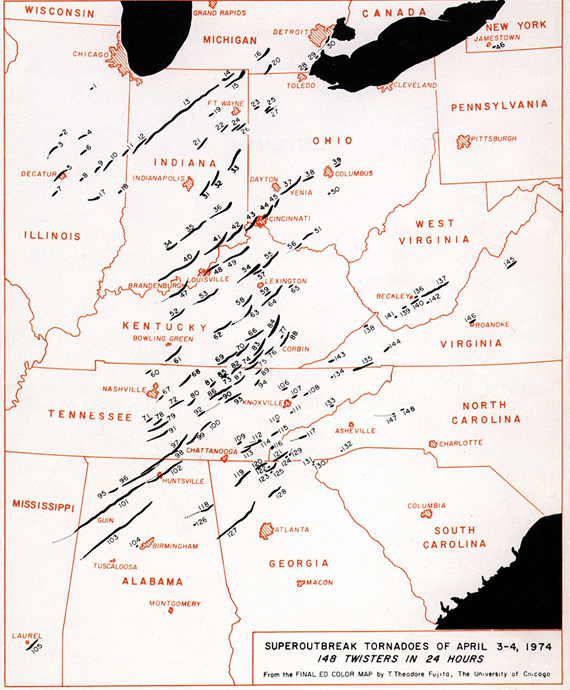The April 1974 Super Outbreak of Tornadoes - National Weather Service Heritage

The April 1974 Super Outbreak of Tornadoes
By Dan Valle (dan.valle@noaa.gov)The April 3-4, 1974 Super Outbreak is the second largest outbreak of tornadoes on record and holds the record for the most F5 tornadoes on a single day. At least 148 tornadoes developed during the super outbreak, touching down in 13 states, killing around 335 people, and causing approximately $600 million in damages. The first tornado was reported around 9:30 am CDT on April 3 in Indiana, and the final tornado occurred around 8 am CDT on April 4 in North Carolina, with the peak occurring between 2 pm and 10 pm on April 3.
Dozens of noteworthy tornadoes occurred in a very short amount of time, making the impact even more severe and the recovery process more daunting. Many of the tornadoes moved at speeds exceeding 50 mph, and two in particular followed identical paths, causing more than half of the recorded deaths from the outbreak and striking many communities twice in under an hour. States across the Midwest experienced colossal loss: Ohio, India, Kentucky, Tennessee, and Alabama had about 200 fatalities and over $80 million in damages between them as a result of the tornadoes, one of which was witnessed by NWS employees.
In the aftermath of this catastrophe, it was clear that changes needed to be made, particularly in the areas of public education and awareness. Outside of the NWS, local broadcasters learned they could stay on the air beyond normal operating hours during weather emergencies, and local principalities began to utilize their Emergency Broadcast Systems far more frequently and effectively. NOAA Weather Radio (NWR) proved to be an effective means of disseminating alerts in the larger metropolitan areas during the outbreak, and as a result, NWR was expanded.
This nation’s response to this devastating event paved the way to significant improvements in observations technology, including the development of Doppler Radar and GOES satellites. Furthermore, it brought to light the need for a massive reorganization of the National Weather Service. The resulting Modernization and Associated Restructuring, or MAR, accelerated the agency’s ability to detect storms faster and deliver forecasts and warnings in a more timely manner.
Additional Reading:
- Natural Disaster Survey Report 74-1 The Widespread Tornado Outbreak of April 3-4, 1974: https://www.weather.gov/media/iln/events/19740403/Assessment.pdf
- NOAA/NWS Storm Prediction Center Violent Tornado Webpage: https://www.spc.noaa.gov/exper/outbreaks/
- The NWS Modernization and Associated Restructuring - A Retrospective (Part 1)
- https://vlab.noaa.gov/web/nws-heritage/-/the-nws-modernization-and-associated-restructuring-a-retrospective-part-1-
- The NWS Modernization and Associated Restructuring - A Retrospective (Part 2)
- https://vlab.noaa.gov/web/nws-heritage/-/the-nws-modernization-and-associated-restructuring-a-retrospective-part-2-
